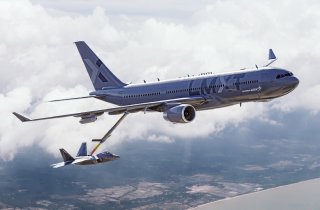LMXT Could Be the New Backbone of U.S. Airpower in the Pacific
This could lead to more capable tanker aircraft being strategically positioned in vital global hotspots having the ability to refuel and extend global missions.
There may soon be more opportunities to refuel fighter jets, extend missions across continents, and increase dwell time over targets due to the Air Force’s new KC-Y Bridge Tanker program.
This program was designed to supplement and fortify the ongoing KC-46 tanker program with a commercially designed system as new planes arrive through the remainder of the decade. The program is crucial, particularly given the fast-increasing need for more “range” and “reach” in attack operations.
Here Comes LMXT
Recently, industry giant Lockheed Martin unveiled its new LMXT aircraft to compete for and support the Air Force tanker effort. Lockheed’s offering is based on the Airbus multirole tanker A330 MRTT aircraft in service with thirteen U.S. allies. It includes a boom/drogue refueling system, fly-by-wire automatic boom/air-to-air refueling systems and advanced sensor cameras.
These days, potential adversaries have more long-range sensors, drones, weapons and space assets with which to complicate access for both U.S. surveillance missions and possible offensive attack operations. This reality, particularly pressing in the Pacific region given the often discussed “tyranny of distance,” requires extended aerial reach across massive swaths of ocean. This means the United States and its allies in Asia, such as Australia, Japan, Taiwan, will likely be called upon to offer additional “basing” for fixed-wing tankers. This is an added advantage of enormous tactical significance given the importance of persistent Intelligence, Surveillance and Reconnaissance (ISR) and power-projection through an expansive maritime region.
Cargo airplanes delivering supplies and ammunition to troops or simply conducting long-dwell surveillance or anti-submarine missions in the Pacific region could, if supported by additional tankers, travel much farther and sustain key operations over-sensitive, high-value areas such as the South China Sea island chain or areas around Japan and Taiwan.
Given these variables, it comes as no surprise that Lockheed’s offering is, perhaps quite deliberately, tailored for missions in the Pacific region. Company information says it “at 2,000 nautical miles from its departing base the LMXT can offload 60% more fuel than the KC-46A and at 3,000 nautical miles the gap grows to more than 150-percent.” Added to this, Lockheed advocates for the aircraft add that the LMXT can operate from far more airfields in the Pacific than the emerging KC-46 and operates with more fuel capacity.
Clearly, part of the strategy is to fast-track and upgrade commercially-derived aircraft technologies which can be produced quickly yet also hardened and upgraded with specific combat-oriented military technologies. This kind of developmental model is fast becoming more common and weapons developers respond to a pressing need to fast-track more weapons systems to operational status to keep pace with a changing threat environment. Given its proven ability, and the growing technological capacity to upgrade major platforms through software enhancements and the integration of new sensors, command and control systems and mission-specific systems, it would not be surprising if the new tanker took on a longer-term role and became a more prominent, long-term fixture for the Air Force. This could lead to more capable tanker aircraft being strategically positioned in vital global hotspots having the ability to refuel and extend global missions.
Kris Osborn is the defense editor for the National Interest. Osborn previously served at the Pentagon as a Highly Qualified Expert with the Office of the Assistant Secretary of the Army—Acquisition, Logistics & Technology. Osborn has also worked as an anchor and on-air military specialist at national TV networks. He has appeared as a guest military expert on Fox News, MSNBC, The Military Channel, and The History Channel. He also has a Master's Degree in Comparative Literature from Columbia University.
Image: Flickr / U.S. Air Force

